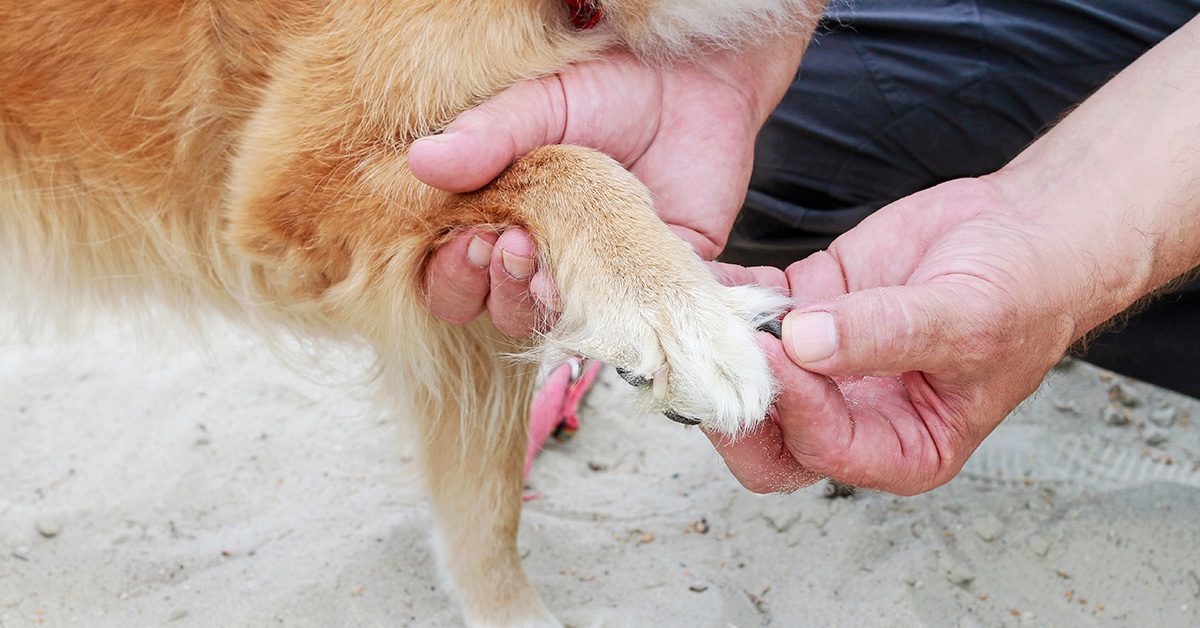Key Points
- A broken nail is one of the most common injuries seen in dogs.
- One of the most common reasons why dogs break or tear their nails is because their nails are too long.
- You can reduce the chance of nails breaking or tearing in the future by regularly trimming your dog’s nails short.
So your dog has a cracked, broken, or torn nail. Don’t panic – we’re here to help!
While a broken nail for us humans is usually a forgettable injury, it’s a more complicated injury for dogs. Broken nails are actually one of the most common accidents we see in puppies, and typically require a visit to the vet or even a trip to the ER depending on severity.
Not only is a broken nail very painful for dogs, but if left untreated, it can result in blood loss, infection, or other complications, so it’s best to consult your vet as soon as possible.
Symptoms
A dog’s nail is made up of two parts. The first part is a hard outer shell known as the claw and is made of keratin. The second part is the nail bed, a collection of blood vessels and nerves that form what is called the quick. The quick is living tissue attached to the bone with a large blood supply and is extremely sensitive. Quick damage can be dangerous, as it causes bleeding or other serious complications if left untreated.
Here are a few common signs that your dog may have a broken nail:
- They’re unable to put pressure on their paw, and are limping or holding their paw off the ground.
- They’re guarding their paw and don’t want you to inspect it.
- They yelp or whine when you touch their claw.
- They’re constantly licking their nail.
- There’s visible blood on the nail or the area where your dog sleeps, such as their bedding.
Common causes of a broken dog nail
- Trimming nails too short: Be careful not to trim your dog’s nails too short, since doing so risks cutting into the quick. And before you reach for your own clippers, remember that it’s essential to use nail trimmers made for dogs.
- Snagging and tearing: One of the most common causes of broken nails in dogs is the nail getting caught on a carpet or other materials such as roots or upholstery. The nail gets snagged on the material and tears as a result. Scenarios like this show why it’s important to properly trim your dog’s nails – this way, their nails won’t grow long enough to get snagged.
- Cracking on hard surfaces: Sometimes, a dog can damage their nail by jumping onto hard surfaces.This can cause the nail to break or bend.
- Aging: As dogs get older, their nails become more brittle and easier to break.
- Illness or cancer: Unfortunately, our furry friends are not immune to disease and sickness, and a broken nail could be a sign of a deeper health problem. For example, two potential signs of melanoma skin cancer are redness and weeping at the junction between the nail and the toe.
Tip: One of the most common nail injuries happens to the dew claw, which is located higher up the side of a dog’s foot. This claw is rarely trimmed – and because it’s higher up, it doesn’t have a chance to get worn down. As a result, it winds up growing longer than the other claws and has an increased chance of snagging on materials and being torn or broken.
Diagnosis
It’s relatively easy to diagnose broken or torn dog nails. If you notice your pup displaying one of the symptoms listed above, inspect them further. Take a close look at their paw, checking in between their toes to determine the exact injury.
If you determine your dog’s nail has been injured, the next step is to assess the severity. If it’s a minor break, you might be able to wait until the next day to see the vet. However, if the break or tear has reached the quick (the vascular section of the nail), there will be quite a bit of blood – so you’ll want to visit your veterinarian as soon as possible. They’ll help you get your pup feeling better in no time!
Treatment
Treatment will depend on how severely broken your dog’s nail is. If you want to err on the side of caution, it’s best to visit your vet, but if you’re tending to your pup’s injury at home, here are some tips:
- If your dog’s nail is bleeding profusely, the first step is to stop the bleeding. Apply gentle, steady pressure to the affected area with a clean cloth, cotton ball, or gauze from a first aid kit.
- Keep the affected area clean. Run some warm water over the affected area and carefully dry it.
- If the nail is loosely attached, you can attempt to gently remove it. But if it isn’t hanging on by a thread, stop and take your dog to a veterinarian.
- If you’re able to stop the bleeding, schedule an appointment with your local veterinarian as soon as possible to examine the claw and see if it needs further treatment or antibiotics. If you’re unable to stop the bleeding, take your dog to the veterinarian immediately.
Tip: Styptic powder or a styptic pencil can help stop the bleeding by clotting the area. You can also use cornstarch, a silver nitrate stick, or cauterizing powder for the same result.
Recovery and care
Once the wound has been treated, it’s important to keep the nail clean and dry. This means no licking is allowed! Of course, preventing your dog from licking their injured paw is often easier said than done, so if they won’t leave it alone, you might need to resort to an Elizabethan collar, aka “the cone of shame.”
It’s also important to keep up with any medications your vet has prescribed to your dog, whether it be pain medication or antibiotics. Your vet will most likely want to see your dog for a follow-up visit to make sure they’re healing well.
Prevention
Since dogs are so active, it’s not uncommon for them to break or tear a nail as they dash across the yard or do a lap of zoomies around the house. To avoid broken or torn nails in the future, be sure to trim your dog’s nails as regularly as possible. Keeping them short will reduce their chances of getting snagged on something.
“If the nails are normal and there is no underlying medical issue, the best way to prevent broken and torn nails is to keep the dog’s nails short and well-trimmed,” says Dr. Jamie Whittenburg, veterinarian and director of Kingsgate Animal Hospital.
And if you aren’t comfortable clipping your pup’s nails yourself – that’s perfectly fine! You can always take your dog to a groomer or vet for help.
Tip: Letting your dog run or walk on coarse, abrasive surfaces such as asphalt or concrete paths can also help keep your dog’s nails at a short length as the ground will wear away at the nails.
What to expect at the vet’s office
Your vet will likely remove the remaining broken or split nail, clean the wound, and apply an antiseptic ointment or powder to help prevent infection of the wound or bone. Next, they’ll wrap the paw to keep it protected through the healing process and send you on your way home with instructions.
Depending on the severity of the wound, your veterinarian may give your pup pain medication or even sedate them before dressing the wound.
FAQs
When should I be worried about my dog’s broken nail?
If your dog has a broken nail, they will most likely need to be examined by a veterinarian at some point. If there’s no bleeding and it seems like a minor break, schedule a visit to your local veterinarian in the next couple of days for a closer look. If the nail is severely broken and you can’t stop the bleeding, take your pup to the veterinarian as soon as possible for treatment.
How do I treat the broken nail?
The first step in treating a broken nail is to assess how severe the damage is. If it’s a minor break, you can clean and bandage the area then take your dog to the vet in the next couple of days for a closer inspection. If the break or tear is severe and the bleeding won’t stop, seek help as soon as you can.
Does pet insurance cover conditions that cause broken nails?
Pet insurance is designed to help you afford the best possible care for unexpected illnesses and accidents, which can include broken dog nails. Be sure to check with your provider or read over your policy if you’re unsure of what’s covered.




